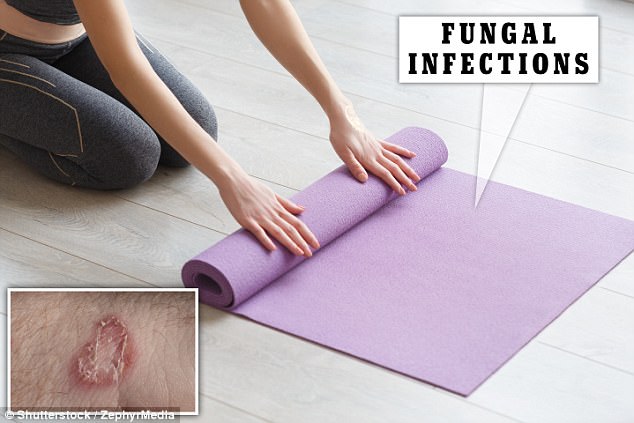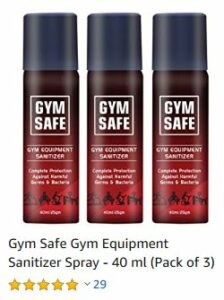5 infections you can pick up at the gym (and how to avoid them)

You go to the gym to get fit, gain some muscle and sweat off some stress. But, you might be picking up a few other things while you’re there…
Unfortunately your gym is a breeding ground for bacteria and germs, and it’s very likely your best intentions to get fit can backfire in the form of a nasty skin or respiratory infection.
In fact, one study by equipment review website Filtrated, found gym equipment carries more germs than a public toilet seat. The research found 70 per cent of gym equipment carry germs that can cause skin infections and illnesses. More specifically, they found treadmills carry an average of 74 times more bacteria than a tap in a public toilet, an exercise bike harbors 39 times more bacteria than a cafeteria tray, and free weights have 362 times more germs than a toilet seat. All three also carry Bacillus – a potential cause of conditions such as ear, eye and respiratory infections.
Feeling nauseous? Same.
Here are the most common infections you can pick up from the gym – and how to avoid them.
1. Staph
What is it?
Aka Stapylococcus Aureus. Staph are a bacteria that lives on the skin and is spread by touching. They’re potentially one of the most serious and common germs lurking in gyms. Around 25 per cent of people normally carry staph in the nose, mouth, genitals or anal area, and don’t have symptoms of infection.
How do you get it?
Staph bacteria are passed from person to person, not surface to person – i.e. through contact. This means you need to worry more if you’re participating in contact sports. However, if you use gym equipment after someone carrying the bacteria and you have an open wound or cut on your hand, you can definitely pick it up.
What are the symptoms?
The infection often begins with a little white cut, which often gets infected with bacteria. This can look like honey-yellow crusting on the skin.
The symptoms range from pimples, boils and milk rashes. However, if the bacteria spreads and gets deeper into your skin, it can lead to pneumonia, sepsis or meningitis.
How do you treat it?
Don’t walk around the gym or washrooms barefoot, and seek immediate help from your GP who will be able to prescribe you antibiotics.
2. Athlete’s foot
What is it?
Athlete’s foot is a fungal infection that affects the upper layer of the skin on the foot, and is most common in warm and moist environments. It’s also known as tinea pedi and ringworm of the foot.
How do you get it?
Contact. Candida, the bacteria that causes athlete’s foot, will be lurking in gyms that have pools, showers, saunas and change rooms. You can catch the fungus through direct contact with an infected person, or by touching surfaces contaminated with the fungus.
What are the symptoms?
According to Health line, there are many possible symptoms of athlete’s foot, including:
- Itching, stinging and burning between your toes or soles of your feet
- Blisters on your feet
- Cracking and peeling skin on your feet
- Dry or raw skin on your feet
- Discolored, thick and crumbly toenails
How do you treat it?
Over-the-counter topical anti-fungal medications are your first bet. If this doesn’t work, your doctor may prescribe something much stronger. Soaking your feet in salt water or diluted vinegar to help dry up blisters is also an effective home remedy.
3. Influenza (aka the flu)
What is it?
You may pick up a cold at the gym, but you could also pick up flu. The flu is an extremely contagious respiratory illness caused by influence A or B viruses.
How do you get it?
It’s contracted through air, so if you breathe in the droplets from someone’s coughs or sneezes, or get the virus on your hands and then proceed to touch your mouth, eyes or nose, then yes – you’ll end up with the flu.
It spreads extremely easily and is most common in cooler months.
What are the symptoms?
In the earliest stages of the flu, your throat may feel irritated, scratchy or sore. This then escalates to a fever, muscle aches, coughing, sneezing, chills, fatigue, lack of energy, and sometimes, nausea and vomiting that lasts up to a week.
How do you treat it?
There is no be-all-end-all cure for the flu, and in most cases the flu is mild enough to treat without prescription medications. This means lots of chicken soup, rest and staying hydrated.
Or you could save yourself from using up your sick leave and simply get a flu shot. You know, just in case.
4. E.coli
What is it?
E.coli (Escherichia coli) are a group of bacteria that are found in the intestines and stools of animals.
How do you get it?
Yes, eating contaminated/raw foods is the most common way, but it can spread into gyms if people who haven’t washed their hands correctly (or at all) after going to the bathroom then proceed to use gym equipment.
What are the symptoms?
Stomach cramps, diarrhea and vomiting – not a fun at all.
How do you treat it?
Just avoid touching your face and mouth at all times while you’re in the gym, and make sure to thoroughly wash your hands after your sweat sesh and whenever you go to the loo.
5. Ringworm
What it is?
Ringworm is a fungal infection that can appear pretty much anywhere, including your arms, legs and midsection.
How do you get it?
Like athlete’s foot, it’s all through contact, and is commonly found in warm and moist environments.
What are the symptoms?
The first stages of ringworm on the skin involves a red, scaly area that may be slightly raised. This worsens rapidly and forms the characteristic ring shape. Sometimes scaling, crusting, or eve blister-like lesions can appear.
How do you treat it?
Avoid the infection in much the same way you would avoid athlete’s foot: Wear flip flops around the gym locker room, wash and dry sweaty clothes and socks, and air out damp shoes. Anti-fungal creams will help ease the symptoms, and your doctor can also prescribe you something stronger if needed.
If Walking into Gym makes you anxious you need to click here





